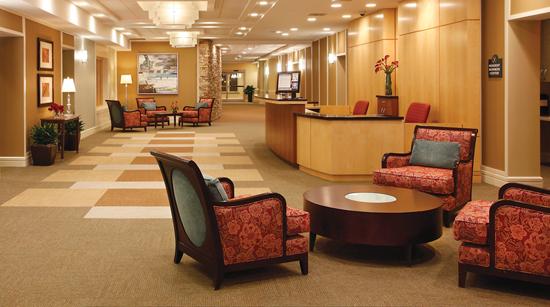Environments for Aging Conference - June 2012
By Ruth Simon McRae
Professionals who work in the senior living market are often driven by more than just profit and financial opportunity. Most people are affected by the challenges of aging, whether it is watching parents and family grow older or experiencing their own process of moving through life stages.
The Environments for Aging conference held in Orlando from April 28 to May 1 is an educational venue for the many professionals whose mission it is to create better, safer, affordable and enjoyable environments for older adults. Vendome Group produced the conference with support from Long Term Living, The Center for Health Design, and HealthCare Design. However, it is the association with the American Institute of Architects (AIA), the Society for the Advancement of Gerontological Environments (SAGE), the International Interior Design Association (IIDA), and the Erickson School that provides the platform for education, whether through sessions, workshops, tours or networking discussions.
The conference creates an opportunity for stakeholders in the design and operation of senior living environments to explore new ideas, unmatched in many other professional settings. Beginning with site tours and workshops, the schedule was packed with a variety of learning opportunities, as well as networking and direct exchange with industry experts, colleagues and suppliers.
Sessions took a comprehensive look at both residential and institutional environments, beginning with a critical study of codes and standards and looking forward into the future. Some presentations offered a fascinating global perspective, with case studies of skilled nursing facilities in both China and Nova Scotia, and universal design research from Japan.
Attendees at the conference represented all aspects of the built environment for senior living. It is the diversity, as well as the quality of educational options, that define this conference.
A breakdown of attendance of the 2011 and 2012 conference shows that approximately 50% of the participants are architects, interior and landscape designers; 25% are owner/operators and administrators of senior care facilities; and 10% to 15% are construction managers and facility planners. The balance is split between academics, government representatives, suppliers and others.
If there was an overriding theme of the conference, it was this: aging is a life stage. The physical and perceptual changes are only one aspect of aging, or as one presentation summarized, “Design for people, accommodate for physical limitation.”
Generous time was allotted in the schedule for attendees to explore the exhibit hall and speak with each vendor. Exhibitors in the conference trade show included several flooring manufacturers: Altro, Forbo, Interface, Lonseal, Milliken, SorbaShock, Tandus and TechDesign Floors.
Even though flooring manufactures participated in the trade show, there was a lack of education in the program concerning flooring. This conference presents a real opportunity to showcase how different types of flooring address the relevant issues in various types of senior housing. There was much information presented during the sessions about the specifics of fixtures for universal design…why not flooring?
Information about the features and benefits of each flooring type, as well as specific information about carpet construction and backing systems, could greatly expand the knowledge base of participants. Evidence based design is a core, shared value, so this audience would be particularly influenced by case studies and research outcomes.
When asked about the need for flooring information and education, Ingrid Fraley, president of Design Services, Inc., contributed these comments: “Professionals in the flooring industry should be interested in this conference, as flooring solutions are a huge investment in any type of environment. Of course aesthetics and price are always considerations, but types of flooring impact users every day, whether due to healthy air quality (low VOCs, antimicrobial properties, anti-static properties), acoustics (sound absorption), mobility (traction, slip resistance, fall mitigation), vision (glare reduction), or orientation (wayfinding).”
The design of environments significantly impacts the quality of life and experiences of seniors, whether they are aging in place or living in a community. The ideal is to create communities that are viable for seniors—or elders, a preferred term—yet include people of a range of ages. There is a desire to create communities that are also diverse from an economic standpoint. To this end, owners and organizations are designing and retrofitting buildings to offer units of different sizes, including some smaller, more affordable spaces.
Continuing care retirement communities (CCRCs) are radically changing, and many sessions addressed how these facilities are dealing with new demographic and economic realities. The driver for this shift is two-fold, the desirability (and greater effectiveness) of a more home-like environment for seniors, and a major reduction in Medicaid reimbursement. Also, many people considering a move to senior communities are delaying action, taking a wait-and-see approach until their current housing and investments increase in value.
A number of larger campuses, built in the 1980s and ’90s, are ripe for re-invention. Some of the ways this is being accomplished is through the creation of smaller “households” within larger facilities, and the renovation and repositioning of areas that were once skilled nursing into assisted living, memory-care and rehabilitation units.
Some participants specifically chose this conference in order to get ideas about how to transform their facilities.
Another hot topic was aging in place, with discussions about how many of the aspects of universal design can be used to retrofit home spaces. Many attendees are applying universal design criteria in all aspects of living/working environments.
Attendees left the event energized and inspired, looking forward to the next Environments for Aging annual conference, to be held in April 7 to 10, 2013 in New Orleans.
Copyright 2012 Floor Focus
Related Topics:Interface, The American Institute of Architects
